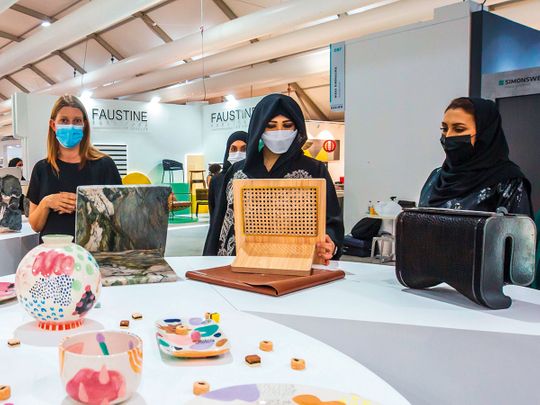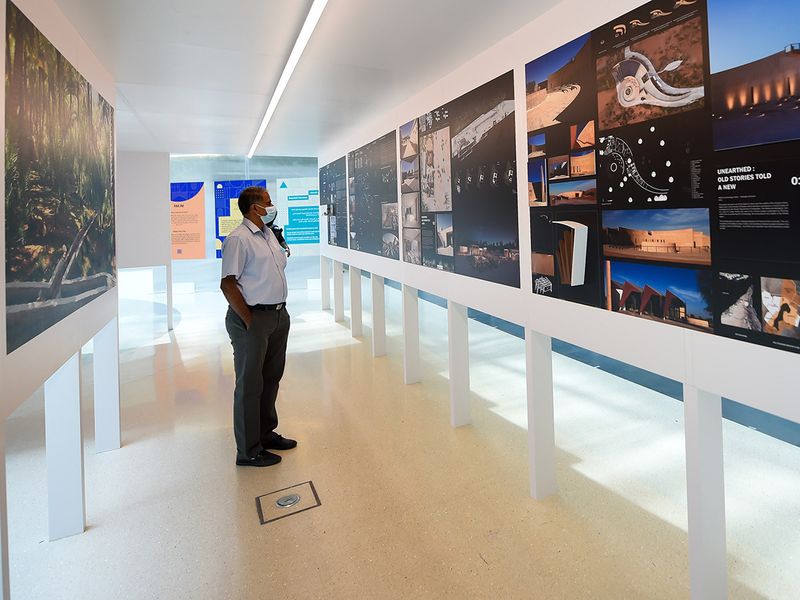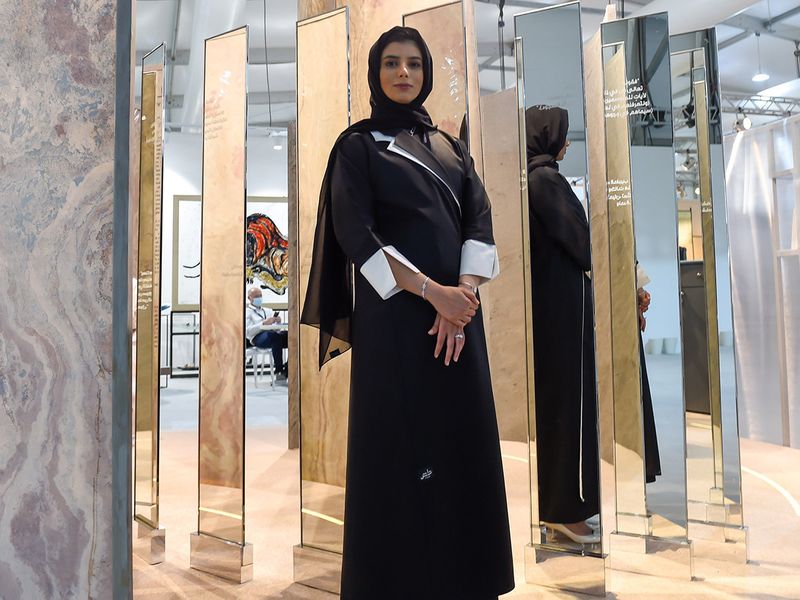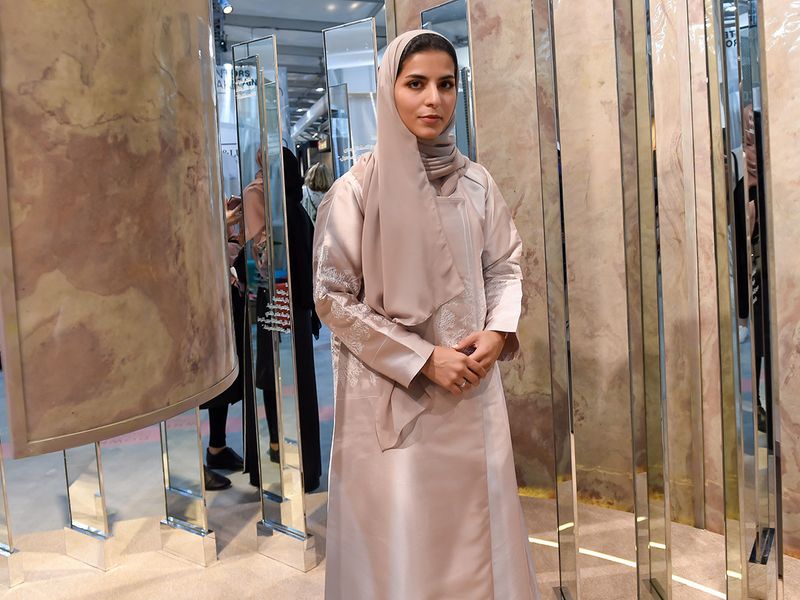
Dubai: What Dubai could look like in the next 20 years and the creative works of Emirati designers attempting to revive their cultural identity were highlights of the seventh edition of ‘Dubai Design Week’ that opened on Monday.
As many as 430 UAE-based designers and 560 companies are taking part in the region’s leading creative festival that hosts 260 free-to attend events and activities at its main hub in Dubai Design District (d3) and around the city till November 13.
Staged in strategic partnership with d3 alongside Dubai Culture and Arts Authority (Dubai Culture) and supported by A.R.M. Holding, Dubai Design Week 2021 presents diverse programmes, from exhibitions, pop-ups and installations to talks, masterclasses and hands-on workshops, accessible for visitors of all ages and levels of skill.
Designing solutions
While inaugurating Dubai Design Week 2021, Sheikha Latifa bint Mohammed bin Rashid Al Maktoum, chairperson of Dubai Culture, said: “Dubai Design Week goes beyond presenting aesthetic and practical designs, but also design solutions to complex global challenges, with the potential to enhance our day to day lives and even our future. We are proud of the growth of this incredible platform over the years and invite everyone to immerse themselves in all that this design week has to offer.”
Khadija Al Bastaki, executive director of d3 said the event, cemented Dubai’s position as a ‘UNESCO City of Design’ and a global creative capital. “It is always our mission at d3 to bring the design and creative community together, to exchange ideas, nurture and showcase talent, learn, collaborate and inspire – and Dubai Design Week certainly does this,” she said.
How will Dubai look in 20 years?
One of the highlights at the festival is a multi-media exhibition titled ‘2040: d3 Architecture Exhibition’ that features concepts envisioning the future of the city in accordance with the goals of ‘The Dubai 2040 Urban Master Plan’ for a sustainable urban development.

“[The exhibition] focuses on our own city, Dubai, and showcases innovative ideas and concepts that bring the vision of the Dubai 2040 Urban Master Plan to life,” said Al Bastaki.
Architects practicing at architectural firms Beyrac Architects, Dabbagh Architects, MEAN* Middle East Architecture Network in collaboration with Concreative, RMJM Dubai and Tariq Khayyat Design Partners (TKDP) were invited to come up with the city’s design in line with the master plan.
The exhibition is presented across four themed zones that align with the goals of the masterplan - Mobility and Transportation, Public and Recreational Spaces, Accessibility to Infrastructure and Eco Tourism.
Sawsan Beyrac, architect and CEO at Beyrac Architects, said the proposed designs represent a dynamic city that connects districts together with accessibility to infrastructure in the best possible way for its residents to live in their city while being closer to nature.

Fast trams on DFC Road
An example of this is how Dubai Financial Centre Road has been redesigned.
“It is a high-speed road designed only for cars, flanked by high-rise buildings. We have designed a futuristic urban transportation solution that provides public transportation alternatives, thereby reducing the need for cars – fast, electrical tramway cabins running on a green band that cross the Dubai Financial Centre Road and leads all the way to the beach,” she added.

Drone taxi station near Dubai Mall
Cycle tracks and shaded pedestrian walkways have been designed en route in line with sustainability goals of the master plan. The roof of Dubai Mall is redesigned to have organic photovoltaic cells to power the entire mall. Apart from pedestrian walkways and tramway, a drone taxi station has also been envisaged in the design. Sky Garden on Sheikh Zayed Road
In the redevelopment design of Sheikh Zayed Road, a concept has been introduced to create an esplanade that reduces noise on the highway crossing the middle of the city while also providing a connection between the residential areas and commercial places that enhance the landscape.
The connection plaza will have pedestrian and bike lanes. With a turtle shape, it is designed to have lower temperature than the surrounding areas.
A Sky Garden that provides sports and play areas between the high-rise buildings has also been suggested to give a new identity to spaces between most important roads.
A tramway is the major highlight of a design that is proposed to redevelop Jumeirah and Al Wasl Road.
Emirati talent in focus
The festival has become a major platform focusing on Emirati talents, said Emirati designer Fatma Al Mahmoud, who is a guest curator for the Dubai Design Week.
She is curating a daily programme of gatherings titled ‘Meet the UAE Creatives’ to bring the local creative community and its stakeholders together in a series of engaging dialogues in an informal setting in one of d3’s bespoke eateries.

The participants include Abdalla Almulla, Hani Asfour, Lujain Abulfaraj, Laila Binbrek and Lina Ghalib, around topics such as, graphic design and content creation as well as design education and production in the UAE.
“With every passing year, we can see how the local creative community is growing. We are focusing on showcasing designs that represent our culture and identity, rather than getting inspired by other cultures,” said Al Mahmoud, who is also the head of 1971 Design Space.
The Sharjah-based multi-functional design space that promotes Emirati creatives is presenting the work of Jawaher Al Khayyal in collaboration with LBO Studio at the Design Week.

Al Khayyal is displaying an installation titled ‘We are the Imprints’ that revives the forgotten science of physiognomy translated as ‘Firaasa’ amongst Arabs.
Collaborating with emerging Emirati creative Hessa Al Suwaidi, Bentley Motors is presenting ‘Safeefa’, a creative concept drawing from an integral part of traditional Emirati weaving and the Bentley brand’s design and craftsmanship.
Omar Al Gurg, another Emirati designer, who is showcasing his designs under the brand “Modu Method,” said the festival has become a major platform for budding designers like him to display their works and connect with contemporaries from other countries.
Providing a platform for emerging creatives, the UAE Designer Exhibition 2.0 presents over 30 emerging and undiscovered talents ranging from Al Gurg and Farah Ahmed’s furniture pieces, to textile design from Shaikha AlTeneiji and Haneen Chaarawi, alongside contemporary pieces and objects created using modern manufacturing technologies, by Alaa Shibly, Nyxo Studio, Sara Al Harbali and more.
The exhibition also showcases a range of handmade homeware accessories using traditional craft techniques by Aditi Patwari, Nora Mohammed and Raghad Al Ali, among others.
Other highlights
Around the city, an array of events will be held in conjunction with Dubai Design Week; from the opening of Dubai’s first collectible design gallery, COLLECTIONAL, launching with an exhibition titled ‘The Shape of Things to Come’ and showcasing an exclusively commissioned collection by internationally acclaimed designer Sabine Marcelis, to a host of dynamic showcases at the Jameel Arts Centre and Alserkal Avenue, amongst others.
Returning with more than 150 international and regional exhibiting brands, the region’s leading fair for original and high-quality design, Downtown Design is back at its bespoke venue on the d3 Waterfront
MENA Grad Show features 60 of the most innovative ideas and solutions to make the world a better place from the brightest minds coming out of the region’s universities, in the fields of technology, science and design
An annually themed initiative supported by A.R.M. Holding, the Urban Commissions 2021 winning proposal ‘Yowalah’ by Beirut-based Bits to Atoms showcases an interactive intervention under the theme of PLAY!
An immersive showcase, AlUla Design will take visitors on a journey to the Saudi Arabian landmark destination and its cultural significance.
The Beirut Concept Store features works by 50 established designers and emerging creatives based in Lebanon in a showcase curated by Mariana Wehbe, presenting the diversity and talent of the Lebanese creative, from tableware and stationary to books and small gift items.
This year’s Abwab commission was awarded to Dubai-based architect Ahmed El-Sharabassy for his pavilion ‘Nature in Motion’ by responding to the theme of regenerative architecture and restorative design.
Curated with people and the planet in mind, the Making Space hosts a programme of more than 80 workshops for visitors of all ages and levels of experience, under the theme of ‘Paper, Plastic + Play’
On the weekend of November 12 and 13, The Marketplace will present an even more varied experience, with a curated selection of original, high-quality products and 50+ new participants this year
This year the fair hosts five national collective showcases from Austria, France, Hungary, Italy and Spain, while Downtown Editions.
The fair’s boutique section dedicated to limited-edition and bespoke design will feature works of four designers selected for the 2021 Tanween Programme by Tashkeel, unveiled at the fair.
The architectural pavilion will host an exhibition titled ‘Pulp Fusion’ around the topic of the human impact on the planet, curated and produced by Bits to Atoms.
A colourful outdoor installation built from recycled materials, ‘Connectivity’ by Kart Group represents the significance and beauty of social connections, while celebrating the diversity of Dubai.
‘The Plume’ by Mohammad Mazen, a student at Ajman University College of Architecture, Art and Design, is inspired by migratory birds which reflects the educational journey and is built using recycled aluminum and acrylic materials.





